#muhammara dip
Explore tagged Tumblr posts
Text
Heard Of Muhammara Dip? Enjoy This Spicy Red Pepper Dip With Pita Bread
Are you on the lookout for a different dip to enjoy? Are you tired of pairing your pita bread with hummus? Do you want a spicy spread that is easy to make? If yes, then you have to try Muhammara. This dip/ spread is generally considered to be of Middle Eastern origin. It is an innovative and wholesome way to cook red bell peppers or capsicums. You can scoop up Muhammara with pita bread, lavash…

View On WordPress
#meditteranean diet#middle eastern cuisine#middle eastern food#middle eastern heritage#muhammara#muhammara dip#muhammara dip recipe
0 notes
Text
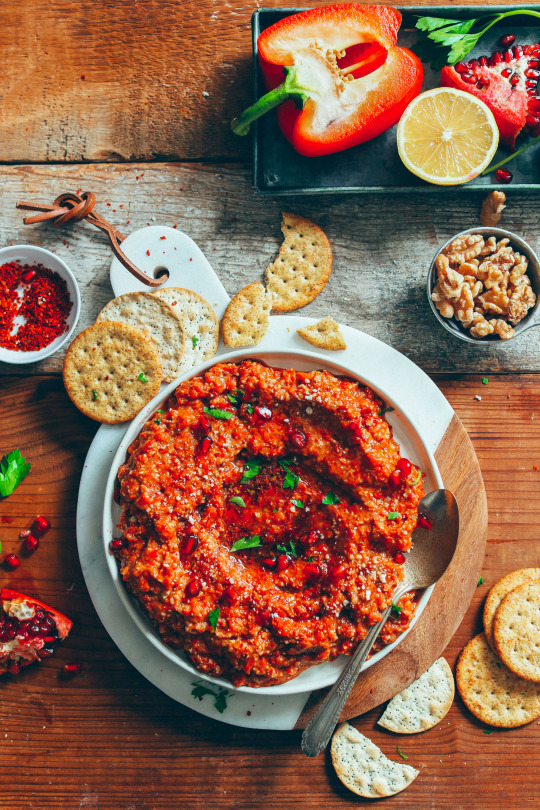
Easy Muhammara Dip / Syrian Spicy Pepper Dip (Vegan & Gluten-Free)
#vegan#gluten free#easy to raw veganize#dips#snacks#appetizer#muhammara#syrian cuisine#middle eastern cuisine#mediterranean cuisine#bell peppers#aleppo#chili#walnuts#pomegranate molasses#garlic#cumin#olive oil#lemon#breadcrumbs#sea salt#crackets#west asian cuisine#❤️
146 notes
·
View notes
Photo


Muhammara
#eato#eat#food#syrian food#red pepper dip#nutty#spicy#muhammara#pita#veggies#roasted red peppers#red peppers#bread crumbs#walnuts#garlic#cumin#lemon#lemon juice#olive oil#yummy#tasty#middle eastern food#delicious#aleppo pepper flakes#pomegranate molasses#spread#dip
4 notes
·
View notes
Photo

(via Muhammara Roasted Red Pepper and Walnut Dip Recipe - Living The Gourmet)
0 notes
Text
Muhammara Rice
Muhammara is a middle eastern dip made from walnut and roasted red pepper dip. The pomegranate molasses and Aleppo pepper flakes give it a savory, sweet, smoky, and tart taste. I made this recipe a few days back, and I had some leftovers after we enjoyed it with some pitas. Nothing goes wrong when you have a dip like this and leftover rice. Just combine them and you have the most delicious rice…

View On WordPress
#cashew rice#dinner recipe#dip#fried rice#middle eastern recipe#muhamara#muhammara#muhammara rice#rice#rice recipe#vegan dinner recipe#vegan dip#walnut rice
1 note
·
View note
Text
Palestinian Recipes from The Immigrant Cookbook by Leyla Moushabeck
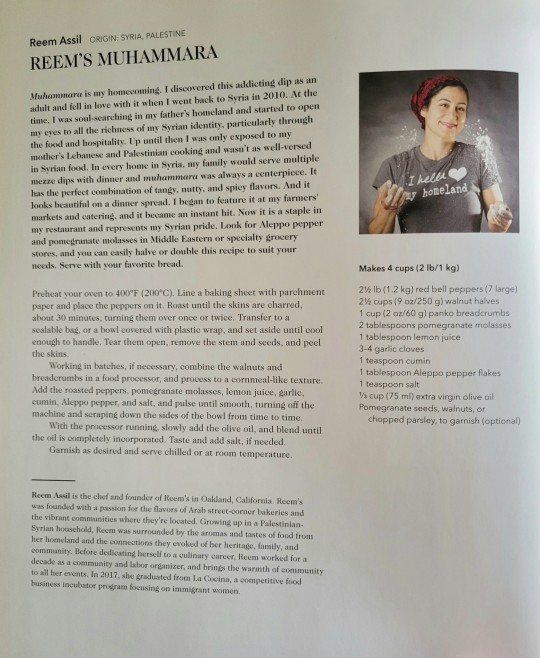
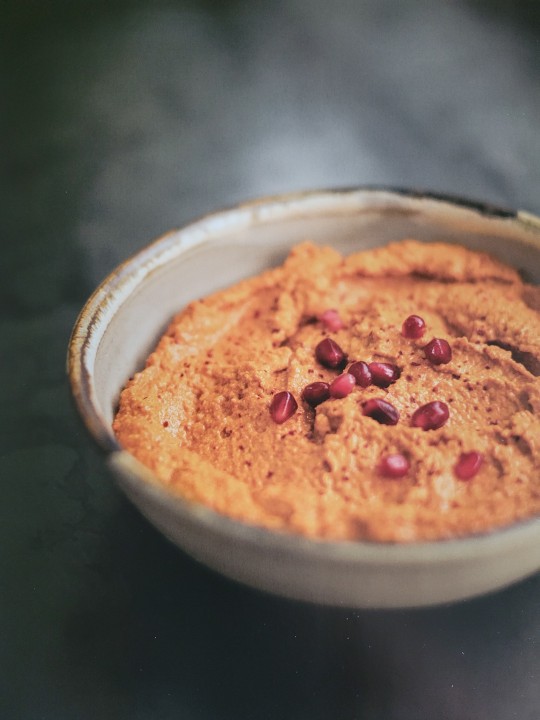
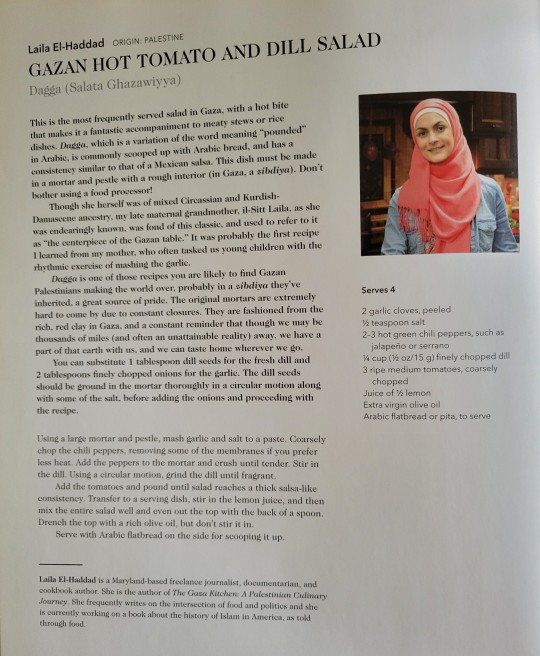
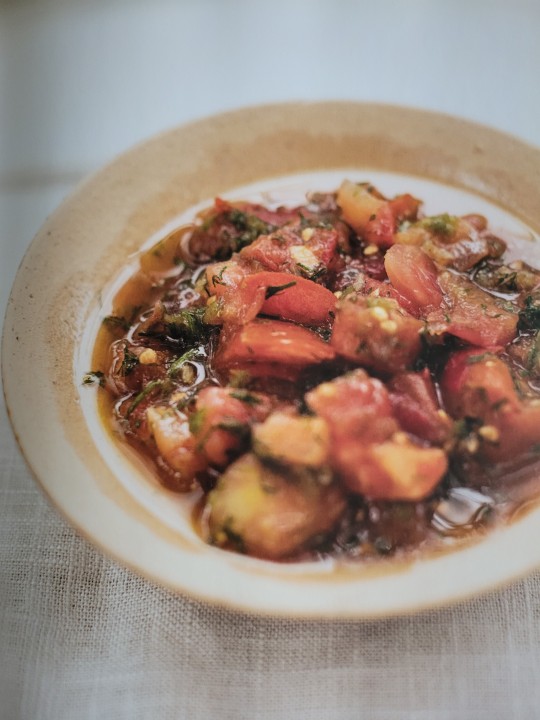
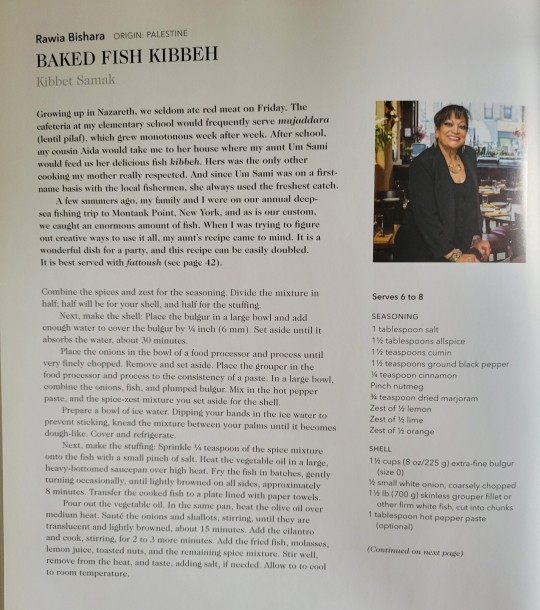
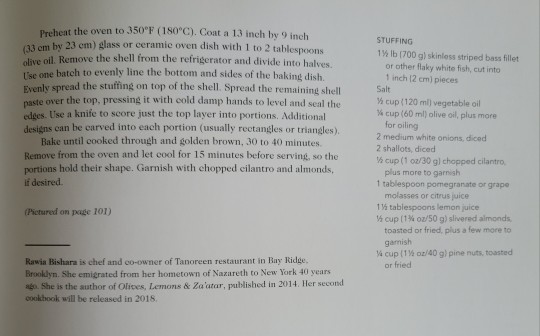
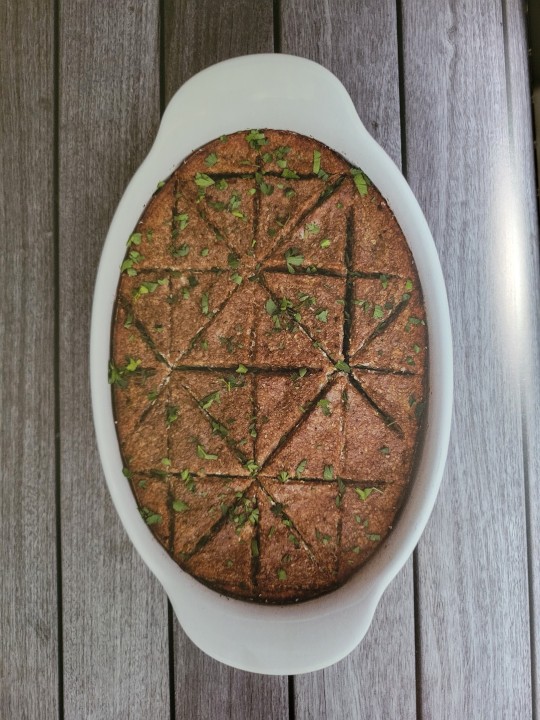
Full page transcripts under the cut:
Recipe #1: Reem's Muhammara
Photo Credit: Jung Fitzpatrick Photography and Ricarius Photography
"Muhammara is my homecoming. I discovered this addicting dip as an adult and fell in love with it when I went back to Syria in 2010. At the time, I was soul-searching in my father's homeland and started to open my eyes to all the richness of my Syrian identity, particularly through the food and hospitality. Up until then I was only exposed to my mother's Lebanese and Palestinian cooking and wasn't well-versed in Syrian food. In every home in Syria, my family would serve multiple mezze dips with dinner and muhammara was always a centerpiece. It has the perfect combination of tangy, nutty, and spicy flavors. And it looks beautiful on a dinner spread. I began to feature it at my farmers' markets and catering, and it became an instant hit. Now it is a staple in my restaurant and represents my Syrian pride. Look for Aleppo pepper and pomegranate molasses in Middle Eastern or specialty grocery stores, and you can easily halve or double this recipe to suit your needs. Serve with your favorite bread."
Makes 4 cups (2 lb / 1 kg)
Ingredients:
2 1/2 lb (1.2 kg) red bell peppers (7 large)
2 1/2 cups (9 oz / 250 g) walnut halves
1 cup (2 oz / 60 g) panko breadcrumbs
2 tablespoons pomegranate molasses
1 tablespoon lemon juice
3-4 garlic cloves
1 teaspoon cumin
1 tablespoon Aleppo pepper flakes
1 teaspoon salt
1/3 cup (75 ml) extra virgin olive oil
Pomegranate seeds, walnuts, or chopped parsley, to garnish optional)
Directions:
Preheat your oven to 400F (200C). Line a baking sheet with parchment paper and place the peppers on it. Roast until the skins are charred, about 30 minutes, turning them over once or twice. Transfer to a sealable bag, or a bowl covered with plastic wrap, and set aside until cool enough to handle. Tear them open, remove the stem and seeds, and peel the skins.
Working in batches, if necessary, combine the walnuts and breadcrumbs in a food processor, and process to a cornmeal-like texture. Add the roasted peppers, pomegranate molasses, lemon juice, garlic, cumin, Aleppo pepper, and salt, and pulse until smooth, turning off the machine and scraping down the sides of the bowl from time to time.
With the processor running, slowly add the olive oil, and blend until the oil is completely incorporated. Taste and add salt, if needed.
Garnish as desired and serve chilled or at room temperature.
"Reem Assil is the chef and founder of Reem's in Oakland, California. Reem's was founded with a passion for the flavors of Arab street-corner bakeries and the vibrant communities where they're located. Growing up in a Palestinian-Syrian household, Reem was surrounded by the aromas and tastes of food from her homeland and the connections they evoked of her heritage, family, and community. Before dedicating herself to a culinary career, Reem worked for a decade as a community and labor organizer, and brings the warmth of community to all her events. In 2017, she graduated from La Cocina, a competitive food business incubator program focusing on immigrant women."
Recipe #2: Gazan Hot Tomato And Dill Salad
Dagga (Salata Ghazawiyya)
Photo Credit: Ricarius Photography
"This is the most frequently served salad in Gaza, with a hot ite that makes it a fantastic accompaniment to meaty stews or rice dishes. Dagga, which is a variation of the work meaning "pounded" in Arabic, is commonly scooped up with Arabic bread, and has a consistency similar to that of a Mexican salsa. This dish must be made in a mortar and pestle with a rough interior (in Gaza, a zibdiya). Don't bother using a food processor!
Though she herself was of mixed Circassian and Kurdish-Damascene ancestry, my late maternal grandmother, il-Sitt Laila, as she was endearingly known, was fond of this classic, and used to refer to it as "the centerpiece of the Gazan table." It was probably the first recipe I learned from my mother, who often tasked us young children with the rhythmic exercise of mashing garlic.
Dagga is one of those recipes you are likely to find Gazan Palestinians making the world over, probably in a zibdiya they've inherited, a great source of pride. The original mortars are extremely hard to come by due to constant closures. They are fashioned from the rich, red clay in Gaza, and a constant reminder that though we may be thousands of miles (and often an unattainable reality) away, we have a part of that earth with us, and we can taste home wherever we go.
You can substitute 1 tablespoon dill seeds for the fresh dill and 2 tablespoons finely chopped onions for the garlic. The dill seeds should be ground in the mortar thoroughly in a circular motion along with some of the salt, before adding the onions and proceeding with the recipe."
Serves 4
Ingredients:
2 garlic cloves, peeled
1/2 teaspoon salt
2-3 hot green chili peppers, such as jalapeno or serrano
1/4 cup (1/2 oz / 15 g) finely chopped dill
3 ripe medium tomatoes, coarsely chiopped
Juice of 1/2 lemon
Extra virgin olive oil
Arabic flatbread or pita, to serve
Directions:
Using a large mortar and pestle, mash garlic and salt to a paste. Coarsely chop up the chili peppers, removing some of the membranes if you prefer less heat. Add the peppers to the mortar and crush until tender. Stir in the dill. Using circular motion, grind the dill until fragrant.
Add the tomatoes and pound until salad reaches a thick salsa-like consistency. Transfer to a serving dish, stir in the lemon juice, and then mix the entire salad well and even out the top with the back of a spoon. Drench the top with a rich olive oil, but don't stir it in.
Serve with Arabic flatbread on the side for scooping it up.
"Laila El-Haddad is a Maryland-based freelance journalist, documentarian, and cookbook author. She is the author of The Gaza Kitchen: A Palestinian Culinary Journey. She frequently writes on the intersection of food and politics and she is currently working on a book about the history of Islam in America, as told through food."
Recipe #3: Baked Fish Kibbeh
Kibbet Samak
Photo Credit: Ricarius Photography
"Growing up in Nazareth, we seldom ate red meat on Friday. The cafeteria at my elementary school would frequently serve mujaddara (lentil pilaf), which grew monotonous week after week. After school, my cousin Aida would take me to her house where my aunt Um Sami would feed us her delicious fish kibbeh. Hers was the only other cooking my mother really respected. And since Um Sami was on a first-name basis with the local fisherman, she always used the freshest catch.
A few summers ago, my family and I were on our annual deep-sea fishing trip to Montauk Point, New York, and as is our custom, we caught and enormous amount of fish. When I was trying to figure out creative ways to use it all, my aunt's recipe came to mind. It is a wonderful dish for a party, and this recipe can be easily doubled. It it best served with fattoush."
Serves 6 to 8
Ingredients:
SEASONING
1 tablespoon saly
1 1/2 tablespoon allspice
1 1/2 teaspoons cumin
1 1/2 teaspoons ground black pepper
1/4 teaspoon cinnamon
Pinch nutmeg
3/4 teaspoon dried marjoram
Zest of 1/2 lemon
Zest of 1/2 lime
Zest of 1/2 orange
SHELL
1 1/2 cups (8 oz / 225 g) extra-fine bulgur (size 0)
1/2 small white onion, coarsely chopped
1 1/2 lb (700 g) skinless grouper fillet or other firm white fish, cut into chunks
1 tablespoon hot pepper paste (optional)
STUFFING
1 1/2 (700 g) skinless striped bass fillet or other flaky white fish cut into 1 inch (2 cm) pieces
Salt
1/2 cup (120 ml) vegetable oil
1/4 cup (60 ml) olive oil, plus more for oiling
2 medium white onions, diced
2 shallots, diced
1/2 cup (1 oz / 30 g) chopped cilantro, plus more to garnish
1 tablespoon pomegranate or grape molasses or citrus juice
1 1/2 tablespoons lemon juice
1/2 cup (1 3/4 oz / 50 g) slivered almonds, toasted or fried, plus a few more to garnish
1/4 cup (1 1/2 oz / 40 g) pine nuts, toasted or fried
Directions:
Combine the spices and zest for the seasoning. Divide the mixture in half; half will be for your shell, and half for the stuffing.
Next, make the shell: Place the bulgur in a large bowl and add enough water to cover the bulgur by 1/4 inch (6 mm). Set aside until it absorbs the water, about 30 minutes.
Place the onions in the bowl of a food processor and process until very finely chopped. Remove and set aside. Place the grouper in the food processor and process to the consistency of a paste. In a large bowl, combine the onion, fish, and plumped bulgur. Mix in the hot pepper paste, and the spice-zest mixture you set aside for the shell.
Prepare a bowl of ice water. Dipping your hands in the ice water to prevent sticking, knead the mixture between your palms until it becomes dough-like. Cover and refrigerate.
Next, make the stuffing: Sprinkle 1/4 teaspoon of the spice mixture onto the fish with a small pinch of salt. Heat the vegetable oil in a large, heavy-bottomed saucepan over high heat. Fry the fish in batches, gently turning occasionally, until lightly browned on all sides, approximately 8 minutes. Transfer the cooked fish to a plate lined with paper towels.
Pour out the vegetable oil. In the same pan, heat the olive oil over medium heat. Saute the onions and shallots, stirring, until they are translucent and lightly browned, about 15 minutes. Add the cilantro and cook, stirring, for 2 to 3 more minutes. Add the fried fish, molasses, lemon juice, toasted nuts, and remaining spice mixture. Stir well, remove from the heat, and taste, adding salt, if needed. Allow to cool to room temperature.
Preheat the oven to 350F (180C). Coat a 13 inch by 9 inch (33 cm by 23 cm) glass or ceramic oven fish with 1 to 2 tablespoons olive oil. Remove the shell from the refrigerator and divide into halves. Use one batch to evenly line the bottom and sides of the baking dish. Evenly spread the stuffing on top of the shell. Spread the remaining shell paste over the top, pressing it with cold damp hands to level and seal the edges. Use a knife to score just the top layer into portions. Additional designed can be carved into each portion (usually rectangles or triangles).
Bake until cooked through and golden brown, 30 to 40 minutes. Remove from the oven and let cool for 15 minutes before serving, so the portions hold their shape. Garnish with chopped cilantro and almonds, if desired.
"Rawa Bishara is a chef and co-owner of Tanoreen restaurant in Bay Ridge, Brooklyn. She emigrated from her hometown in Nazareth to New York 40 years ago. She is the author of Olives, Lemons & Za'atar, published in 2014. Her second cookbook will be released in 2018."
14 notes
·
View notes
Note
For the meme, 7, 33, 50!
7. Any groceries you’ve been getting into lately?
at some point i became a potato salad snob. i used to be fine with the kroger brand mass-produced stuff but now i'm pretty much like Met Market's Red White & Bleu Potato Salad Or Bust. so when i need to get myself a little treat i go to their lil deli department and load up on that potato salad specifically. i expect at some point i will become too snobby even for this and then have to figure out how to make my own damn potato salad to meet my own highly specific tastes
also pita is pretty great??? i love lazy dinners and pita + hummus, muhammara, pimento cheese dip, etc, is just. a+++, most loved bread in our house atm
33. What’s something you collect?
i already collected stuffed animals at an alarming rate prior to meeting my partner and fortunately/unfortunately he is the worst enabler so like. i have Opinions on the best plushie brands. i have paid remailer services more than once to get me a cool plushie that was only sold in Norway or Japan or whatnot. literally this weekend i was killing time in a mall, and was about to buy the CUTEST lil woodpecker stuffed animal b/c he was just a lil guy and he was going to look great on the dashboard of my car... and then my partner had to be like "lua, don't buy it, i actually already bought one for you when you weren't looking and was planning to gift it to you as soon as we left the store" lmao
anyway yeah i thought i would grow out of stuffed animals once i was no longer a kid but turns out the only thing that's changed is better finances with which to buy more stuffed animals lol
50. Pro or anti throw pillows?
i guess i'm not anti in the sense of i think they look nice in other people's places but uhhhh. i don't think i've owned one since college and i probably haven't made my bed in like a month lmao, so yeah, no throw pillows here
10 notes
·
View notes
Text
just planned my nye menu (cauliflower shawarma with homemade dips (houmous and muhammara and whipped feta) and then coffee mousse with tahini fudge) and lemme tell you, i wish i could share it with all of you along with several glasses of prosecco (or your favourite non-alcoholic alternative).
21 notes
·
View notes
Text

Superb Owl dips
Spinach artichoke (top)
And Muhammara hot damn!!!!
#food#foodblogger#foodblr#foodphotography#vegetarian#dinner#foodpics#lettucecook#the spinach artichoke was vegetarian and the muhammara was vegan 🥳#adding roasted carrot to the muhammara was damnnn good.
5 notes
·
View notes
Photo

Quinoa, kale and eggplant bowl with muhammara
An earthy and satisfying vegan dinner bowl of lemony quinoa and kale, grilled eggplant and a generous serving of muhammara – Middle Eastern walnut and red pepper dip.
https://quitegoodfood.co.nz/quinoa-kale-eggplant-bowl-muhammara/
#vegan#food#recipe#vegan food#vegan recipe#vegan recipes#lunch#supper#yum#yummy#delicious#food porn#plant based#healthy#submission
49 notes
·
View notes
Link
Written by Tiffany McCauley. Mediterranean Roasted Red Pepper Dip Recipe (Muhammara Dip)
0 notes
Text

Roasted Red Pepper Butterbean Weetabix Dip (Vegan)
Inspired by the much-loved muhammara dip
#vegan#snacks#appetizer#dips#bean dip#bell peppers#beans#weetabix#walnuts#garlic#paprika#lemon#onion#pomegranate molasses#black pepper#sea salt#charcuterie#tomatoes#cucumber#olives#carrots#grapes#vegan cream cheese#eat the rainbow
20 notes
·
View notes
Text
CHEF ILONA: MUHAMMARA

Muhammara is a rich, flavorful Middle Eastern dip or spread, originating from Aleppo, Syria. It's known for its deep red color and its vibrant blend of smoky, sweet, and spicy flavors. The main ingredients include:
Roasted red peppers: Provide sweetness and a smoky depth.
Walnuts: Add crunch and richness.
Pomegranate molasses: A key ingredient that gives muhammara its tangy, slightly sweet flavor.
Breadcrumbs: For thickness and texture.
Garlic: For a sharp, savory bite.
Olive oil: Adds a silky, smooth finish.
Spices: Typically, cumin and sometimes Aleppo pepper, which adds heat and an earthy flavor.
Muhammara is commonly served as part of a mezze platter with pita bread, vegetables, or crackers. It pairs beautifully with grilled meats and can also be used as a sauce or spread in sandwiches. The combination of nuttiness from the walnuts, the smokiness of the roasted peppers, and the tang from the pomegranate molasses makes it a unique and flavorful dish.
In recent years, muhammara has gained popularity internationally as part of the broader rise in the appreciation of Middle Eastern and Mediterranean cuisine. Its versatility as a dip, spread, or sauce, along with its bold, complex flavors, has made it a favorite among chefs and food enthusiasts around the world.
Muhammara’s history reflects the blending of cultural influences, trade routes, and local agriculture, making it a dish rich in both flavor and heritage.

Muhammara
Serves 6-8
4 red bell peppers, roasted and peeled -or- use jarred roasted red peppers
1 cup walnuts, toasted
2/3 cup fresh breadcrumbs or panko, toasted
2 Tbsp pomegranate molasses
2 cloves garlic
1 teaspoon Aleppo pepper or red pepper flakes
Juice of 1 lemon
2 teaspoon paprika
1 teaspoon cumin
1 teaspoon salt -or- to taste
Few grinds black pepper
4 tablespoons extra virgin olive oil
Combine the peppers and walnuts in a food processor and blend until smooth. Add all the remaining ingredients except the olive oil and pulse until smooth.
With the processor running, add the olive oil slowly and blend until the oil is completely incorporated. Turn off the processor and scrape down the sides of the processor bowl as you go. If you find the dip is too thick, add some of the liquid from the roasted red pepper or a small splash of water until desired texture is achieved.
Serve the muhammara in a small bowl or as an anchor flavour for a canape or a dressed toast.
Garnish options: chopped parsley, mint, pomegranate arils, pomegranate molasses, olive oil, additional chopped walnuts, or cilantro.
#pei#chefilona#canadianchef#eastcoast#chefsofinstagram#cbcpei#eater#yum#explorecanada#foodwriter#MUHAMMARA#syria#aleppo
0 notes
Text
Muhammara
“Arabic word Ahmar, meaning Red“ A few years back I made this dip for a New Year party, and I am making this so frequently that I have lost count. Muhammara is a middle eastern dip made from walnut and roasted red pepper dip. The pomegranate molasses and Aleppo pepper flakes give it a savoury, sweet, smoky, and tart taste. I did not have any Aleppo pepper, so I used regular chili flakes. You…
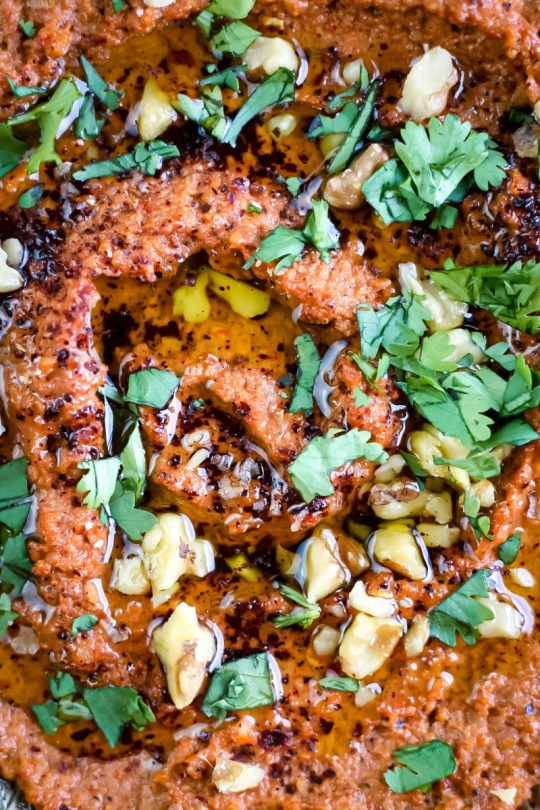
View On WordPress
0 notes
Video
youtube
Muhammara: Veganer Paprika-Walnuss-Dip mit gerösteter Paprika vom Grill–...
0 notes
Text
Popular Lebanese Dips and Spreads: Beyond Hummus
Lebanese cuisine is renowned for its rich flavours, fresh ingredients, and vibrant dishes. While hummus often steals the spotlight, Lebanese dips and spreads offer a world of delightful options. If you’re searching for the best Lebanese restaurant Sydney has to offer, this guide will introduce you to an array of delicious dips and spreads that go beyond hummus, showcasing the diversity and depth of Lebanese culinary traditions.
Introduction to Lebanese Dips and Spreads
Lebanese dips and spreads are a cornerstone of the mezze, a selection of small dishes served as appetisers. These dips are not only delicious but also embody the essence of Lebanese cooking, using fresh vegetables, herbs, and spices to create vibrant flavours and textures. Let's explore some of the most popular Lebanese dips and spreads that you can enjoy at a Lebanese restaurant in Sydney.
Beyond Hummus: Exploring Lebanese Dips
Baba Ganoush: The Smoky Eggplant Dip
What is Baba Ganoush?
Baba ganoush is a beloved Lebanese dip made from roasted eggplant, tahini (sesame paste), lemon juice, garlic, and olive oil. The roasting process gives the eggplant a smoky flavour, which, combined with the creamy tahini, creates a rich and velvety dip.
How to Enjoy Baba Ganoush
Baba ganoush is typically served with warm pita bread or fresh vegetables. Its smoky, tangy taste makes it a perfect complement to a variety of dishes, from grilled meats to fresh salads.
Muhammara: The Spicy Red Pepper and Walnut Dip
What is Muhammara?
Originating from the Levantine region, muhammara is a spicy and slightly sweet dip made from roasted red peppers, walnuts, breadcrumbs, pomegranate molasses, garlic, and a touch of chili pepper. The combination of these ingredients results in a dip that is both flavourful and complex.
How to Enjoy Muhammara
Muhammara is often served with pita bread, but it also makes a great accompaniment to grilled meats and vegetables. Its bold flavour and satisfying texture make it a standout dish in any mezze spread.
Labneh: The Creamy Yoghourt Spread
What is Labneh?
Labneh is a creamy, tangy spread made from strained yoghourt. It has the consistency of cream cheese but offers a lighter, more refreshing taste. Labneh is often garnished with olive oil, za'atar (a blend of herbs and sesame seeds), and fresh herbs.
How to Enjoy Labneh
Labneh is versatile and can be enjoyed in many ways. Spread it on bread, use it as a dip for vegetables, or serve it as a side dish with olives and tomatoes. Its creamy texture and tangy flavour make it a delightful addition to any meal.
Lesser-Known Lebanese Dips
Moutabal: A Variation of Baba Ganoush
What is Moutabal?
Moutabal is similar to baba ganoush but has a slightly different flavour profile. It is made with roasted eggplant, tahini, lemon juice, garlic, and olive oil, but often includes yoghourt, which gives it a creamier texture and a tangier taste.
How to Enjoy Moutabal
Moutabal is served in the same way as baba ganoush, with pita bread or fresh vegetables. Its creamy consistency and rich flavor make it a versatile and satisfying dip.
Tarator: The Versatile Tahini Sauce
What is Tarator?
Tarator is a traditional Lebanese sauce made from tahini, garlic, lemon juice, and water. It has a smooth, creamy texture and a bold, nutty flavour. Tarator is often used as a dressing or a dip and can be found in various Lebanese dishes.
How to Enjoy Tarator
Tarator can be drizzled over grilled meats, used as a dip for vegetables, or spread on sandwiches. It's rich flavour and creamy texture make it a versatile and delicious addition to many dishes.
Toum: The Garlic Lover's Delight
What is Toum?
Toum is a potent garlic sauce made from garlic, lemon juice, oil, and salt. It has a creamy consistency and a strong garlic flavour, making it a favourite among garlic enthusiasts.
How to Enjoy Toum
Toum is typically served with grilled meats, especially chicken, but it can also be used as a spread or a dip. Its intense garlic flavour adds a zesty kick to any dish.

Discovering the Best Lebanese Dips and Spreads in Sydney
If you’re on the hunt for the best Lebanese restaurant Sydney has to offer, make sure to explore the wide variety of dips and spreads available. From the smoky baba ganoush to the spicy muhammara and the creamy labneh to the bold toum, Lebanese cuisine offers a rich array of flavours that go beyond the familiar hummus. These dips and spreads not only enhance any meal but also provide a delicious introduction to the diverse and vibrant world of Lebanese cooking.
Next time you visit a Lebanese restaurant in Sydney, venture beyond hummus and try these delightful dips and spreads. You’ll discover new favourite flavours and gain a deeper appreciation for the culinary traditions of Lebanon.
0 notes